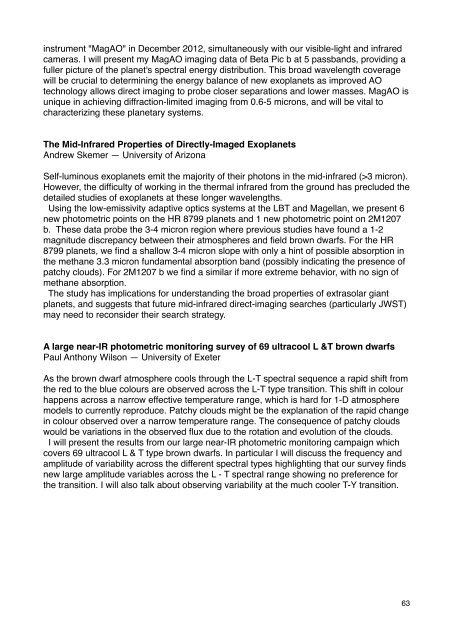Exoclimes_Conference_booklet1
Exoclimes_Conference_booklet1
Exoclimes_Conference_booklet1
You also want an ePaper? Increase the reach of your titles
YUMPU automatically turns print PDFs into web optimized ePapers that Google loves.
instrument "MagAO" in December 2012, simultaneously with our visible-light and infrared<br />
cameras. I will present my MagAO imaging data of Beta Pic b at 5 passbands, providing a<br />
fuller picture of the planet's spectral energy distribution. This broad wavelength coverage<br />
will be crucial to determining the energy balance of new exoplanets as improved AO<br />
technology allows direct imaging to probe closer separations and lower masses. MagAO is<br />
unique in achieving diffraction-limited imaging from 0.6-5 microns, and will be vital to<br />
characterizing these planetary systems.<br />
The Mid-Infrared Properties of Directly-Imaged Exoplanets<br />
Andrew Skemer — University of Arizona!<br />
Self-luminous exoplanets emit the majority of their photons in the mid-infrared (>3 micron).<br />
However, the difficulty of working in the thermal infrared from the ground has precluded the<br />
detailed studies of exoplanets at these longer wavelengths.<br />
Using the low-emissivity adaptive optics systems at the LBT and Magellan, we present 6<br />
new photometric points on the HR 8799 planets and 1 new photometric point on 2M1207<br />
b. These data probe the 3-4 micron region where previous studies have found a 1-2<br />
magnitude discrepancy between their atmospheres and field brown dwarfs. For the HR<br />
8799 planets, we find a shallow 3-4 micron slope with only a hint of possible absorption in<br />
the methane 3.3 micron fundamental absorption band (possibly indicating the presence of<br />
patchy clouds). For 2M1207 b we find a similar if more extreme behavior, with no sign of<br />
methane absorption.<br />
The study has implications for understanding the broad properties of extrasolar giant<br />
planets, and suggests that future mid-infrared direct-imaging searches (particularly JWST)<br />
may need to reconsider their search strategy.<br />
A large near-IR photometric monitoring survey of 69 ultracool L &T brown dwarfs<br />
Paul Anthony!Wilson — University of Exeter<br />
As the brown dwarf atmosphere cools through the L-T spectral sequence a rapid shift from<br />
the red to the blue colours are observed across the L-T type transition. This shift in colour<br />
happens across a narrow effective temperature range, which is hard for 1-D atmosphere<br />
models to currently reproduce. Patchy clouds might be the explanation of the rapid change<br />
in colour observed over a narrow temperature range. The consequence of patchy clouds<br />
would be variations in the observed flux due to the rotation and evolution of the clouds.<br />
I will present the results from our large near-IR photometric monitoring campaign which<br />
covers 69 ultracool L & T type brown dwarfs. In particular I will discuss the frequency and<br />
amplitude of variability across the different spectral types highlighting that our survey finds<br />
new large amplitude variables across the L - T spectral range showing no preference for<br />
the transition. I will also talk about observing variability at the much cooler T-Y transition.<br />
63


